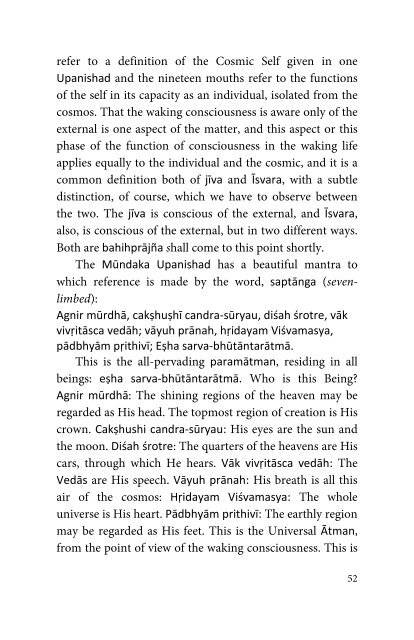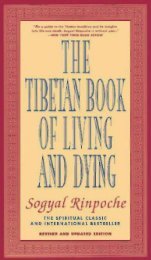Mandukya_Upanishad
Mandukya_Upanishad
Mandukya_Upanishad
You also want an ePaper? Increase the reach of your titles
YUMPU automatically turns print PDFs into web optimized ePapers that Google loves.
efer to a definition of the Cosmic Self given in one<strong>Upanishad</strong> and the nineteen mouths refer to the functionsof the self in its capacity as an individual, isolated from thecosmos. That the waking consciousness is aware only of theexternal is one aspect of the matter, and this aspect or thisphase of the function of consciousness in the waking lifeapplies equally to the individual and the cosmic, and it is acommon definition both of jīva and Īsvara, with a subtledistinction, of course, which we have to observe betweenthe two. The jīva is conscious of the external, and Īsvara,also, is conscious of the external, but in two different ways.Both are bahihprājña shall come to this point shortly.The Mūndaka <strong>Upanishad</strong> has a beautiful mantra towhich reference is made by the word, saptānga (sevenlimbed):Agnir mūrdhā, cakṣhuṣhī candra-sūryau, diśah śrotre, vākvivṛitāsca vedāh; vāyuh prānah, hṛidayam Viśvamasya,pādbhyām pṛithivī; Eṣha sarva-bhūtāntarātmā.This is the all-pervading paramātman, residing in allbeings: eṣha sarva-bhūtāntarātmā. Who is this Being?Agnir mūrdhā: The shining regions of the heaven may beregarded as His head. The topmost region of creation is Hiscrown. Cakṣhushi candra-sūryau: His eyes are the sun andthe moon. Diśah śrotre: The quarters of the heavens are Hiscars, through which He hears. Vāk vivṛitāsca vedāh: TheVedās are His speech. Vāyuh prānah: His breath is all thisair of the cosmos: Hṛidayam Viśvamasya: The wholeuniverse is His heart. Pādbhyām prithivī: The earthly regionmay be regarded as His feet. This is the Universal Ātman,from the point of view of the waking consciousness. This is52



